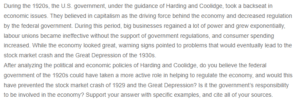Politics and Economics of the 1920s
In the 1920s, America experienced a period of economic boom primarily because of the government’s extremely conservative economic policies. Accordingly, the president during this time, Warren G. Harding, and the vice president, Calvin Coolidge, based these economic policies on the idea that suppose the government was to foster private businesses, then the benefits would exude out to a significant percentage of Americans (Clacket al., 2009). As such, the government tried to create the most favourable environment for the economy through policies like the Hawley-Smoot Tariff and the Fordney-McCumber Tariff. Subsequently, some of these policies were meant to give American manufacturers a monopoly of the domestic market, which meant that international trade was blocked using tariffs (Grossman & Meissner, 2010). However, international countries retaliated by placing tariffs on American goods, leading to overproduction in America. Consequently, a supply glut and a squandering demand led to an economic downturn since producers could no longer sell their products. This is in addition to policies passed by Congress that allowed a huge percentage of tax cuts.
Considering the abovementioned policies and the government’s efforts to promote more business privatization and a conservative approach towards the economy, I believe this unregulation led to highly questionable business dealings, like misguided banking practices (Senate, US 2010). All these factors accumulated to cause the stock market crash of 1929 and, eventually, the Great Depression. In addition, this would not have been the case if the government had adopted different approaches that included an active role in economic regulation. Lastly, yet importantly, the government must regulate the economy (Viscusi et al., 2018). One way to do this is by using monetary tools that control the country’s money supply and moderate the effects of reduction and expansion in the economy to sustain economic steadiness and promote economic progress (Majone, 2019).
References
Clack, G., Neely, M. S., & Hamby, A. (2009). Outline of US history. Nova Science Publishers, Incorporated.
Grossman, R. S., & Meissner, C. M. (2010). International aspects of the Great Depression and the crisis of 2007: similarities, differences, and lessons. Oxford Review of Economic Policy, 26(3), 318-338.
Majone, G. (2019). The rise of the regulatory state in Europe. In The State in Western Europe Retreat or Redefinition? (pp. 77-101). Routledge.
Senate, U. S. (2010). The Pecora Investigation: Stock Exchange Practices and the Causes of the 1929 Wall Street Crash. Cosimo, Inc.
Viscusi, W. K., Harrington Jr, J. E., & Sappington, D. E. (2018). Economics of regulation and antitrust. MIT Press.
ORDER A PLAGIARISM-FREE PAPER HERE
We’ll write everything from scratch
Question

Politics and Economics of the 1920s
During the 1920s, the U.S. government, under the guidance of Harding and Coolidge, took a backseat in economic issues. They believed in capitalism as the driving force behind the economy and decreased regulation by the federal government. During this period, big businesses regained a lot of power and grew exponentially, labour unions became ineffective without the support of government regulations, and consumer spending increased. While the economy looked great, warning signs pointed to problems that would eventually lead to the stock market crash and the Great Depression of the 1930s.
After analyzing the political and economic policies of Harding and Coolidge, do you believe the federal government of the 1920s could have taken a more active role in helping to regulate the economy, and would this have prevented the stock market crash of 1929 and the Great Depression? Is it the government’s responsibility to be involved in the economy? Support your answer with specific examples, and cite all of your sources.

